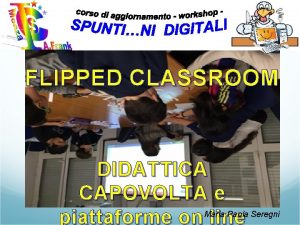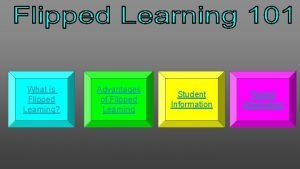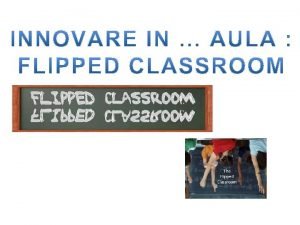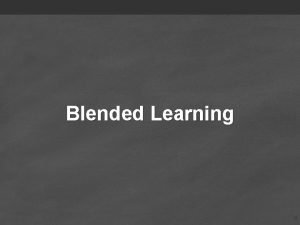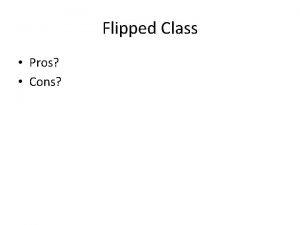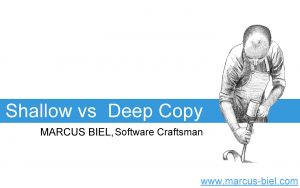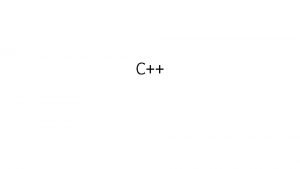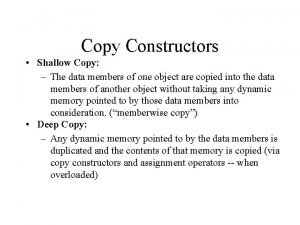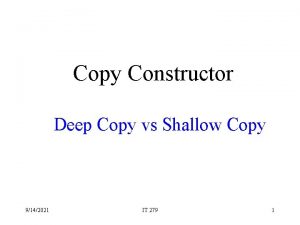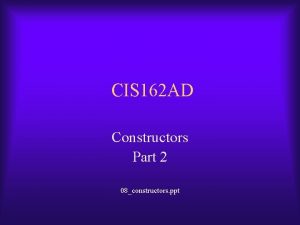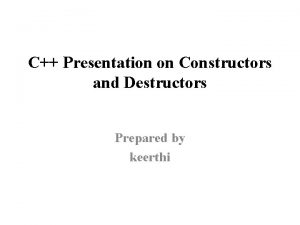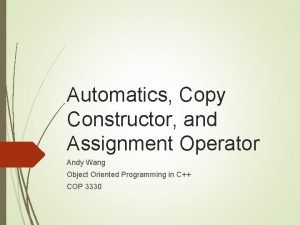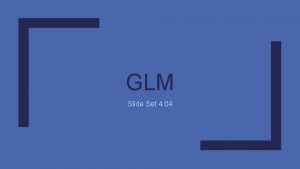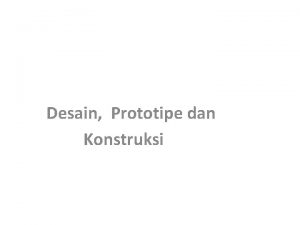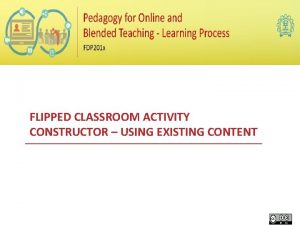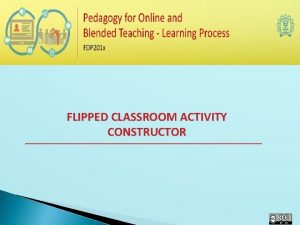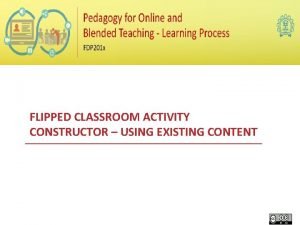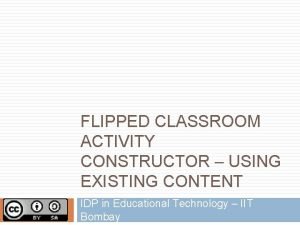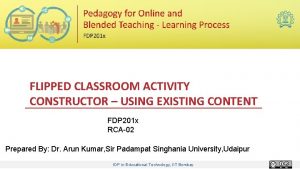FLIPPED CLASSROOM ACTIVITY CONSTRUCTOR USING EXISTING CONTENT FLIPPED























- Slides: 23

FLIPPED CLASSROOM ACTIVITY CONSTRUCTOR – USING EXISTING CONTENT

FLIPPED CLASSROOM ACTIVITY CONSTRUCTOR FDP 201 X IIT BOMBAY

ABOUT 3 K. R. SARODE ASSISTANT PROFESSOR COMPUTER TOPIC: MEMORY SEGMENTATION

K. R. Sarode 4 8086 Segmemtation Microprocessors & Interfacing Computer GCOE Jalgaon 3 rd Year B. E. /B. Tech Students

OUT-OF-CLASS SEGMENT 5 THIS SECTION HELPS YOU DESIGN THE OUT-OFCLASS SEGMENT OF FLIPPED CLASSROOM STRATEGY

Out-of-class Activity Design -1 6 Learning Objective(s) of Out-of-Class Activity: At the end of watching the videos student should be able to § Explain the need of memory segmentation § Explain memory segmentation concept § List the advantages of memory segmentation § 20 bit Physical address generation Key Concept(s) to be covered: • Memory segmentation • Advantages of memory segmentation • Segment registers and their function • 20 -bit physical address generation

Out-of-class Activity Design - 2 7 Uploaded Video URL https: //www. youtube. com/watch? v=Z 16 du 3 GB 1 t. U Total Duration of uploaded video: 12. 24 min License of Video Youtube*

Out-of-class Activity Design - 3 8 Aligning Assessment with Learning Objective Assessment Strategy 1. To explain the need of memory segmentation in 8086 Discuss the need of memory segmentation in 8086 (Understand Level) Expected Duration (in min) 4 minutes Additional Instructions (if any) Watch Video and then write answer and submit in a file before next class.

Additional Slides for Out-of-Class Design 9 Learning Objective Assessment Strategy 2. To explain the concept of memory segmentation in 8086 Q 2. Discuss the concept of memory segmentation in 8086 Expected Duration (in min) Additional Instructions (if any) 4 minutes Watch Video and then write answer and submit in a file before next class. (Understand Level) 3. To know the advantages of memory segmentation (Understand Level) Q. 3 Discuss the advantages of memory segmentation. IDP in Educational Technology, IIT Bombay 4 minutes Watch Video and then write answer and submit in a file before next class.

Additional Slides for Out-of-Class Design 10 Learning Objective Assessment Strategy 4. To explain 20 Q. 4 Explain 20 -bit physical address generation in 8086. IDP in Educational Technology, IIT Bombay Expected Duration (in min) 4 minutes Additional Instructions (if any) Watch Video and then write answer and submit in a file before next class.

Additional Slides for Out-of-Class Design 11 Aligning Assessment with Learning Objective Expected activity duration 15 minutes

In-class Activity Design -1 12 Learning Objective(s) of In-Class Activity: i)Explain segment registers in 8086(Recall level) ii)Generate the 20 -bit physical address for code segment with segment address 1050 H and offset address 5555 H (Understand level). Key Concept(s) to be covered: • Memory segmentation • Segment registers • Displacement / offset within segment

In-class Activity Design -2 13 Active Learning activity(ies) that you plan to do Real world problem solving using 1. Think-Pair-Share 2. Concept clarification using Peer Instruction

Additional Slides for In-Class Activity Design 14 Explain the strategy by giving details of: (You may use additional slides that are provided for detailing) Peer Instruction Strategy – What Teacher Does 1. What are the segment registers in 8086? 2. In which segment the offset is stored? 3. How many segments are there in 1 MB of memory. .

Additional Slides for In-Class Activity Design 15 Peer Instruction Strategy – What Teacher Does 1. What is the range of offset address values? 2. What is physical memory and logical memory?

Additional Slides for In-Class Activity Design 16 Peer Instruction Strategy – What Student Does For each question they will first vote individually Then they will discuss with peers and come to consensus Listen to instructors explanation

Additional Slides for In-Class Activity Design 17 TPS Strategy – What Instructor does Think (~9 minutes) Instruction: (1) What is the maximum size of each segment? And how many such segments are there in 1 MB of address space? Instruction: (2): Tell the address range of 1 MB of memory? Think individually and examine the probability.

Additional Slides for In-Class Activity Design 18 TPS Strategy – What Instructor does Pair (~5 minutes) Instruction: Now pair up and compare your answers. Agree on one final answer. Share (~6 minutes) Instructor asks a group to share their answer with class and see whethere are different answers. After sharing is done, instructor gives feedback on the correct solution

Additional Slides for In-Class Activity Design 19 Answers : (1) The complete 1 MB of memory is divided into 16 logical segments. Each segment contains 64 KB of Memory.

Additional Slides for In-Class Activity Design 20 Answers : (2) The addresses in 1 MB memory ranges from 00000 H to FFFFFH.

Additional Slides for In-Class Activity Design 21 Justify why the above is an active learning strategy In both the above strategies, students are required to go beyond mere listening and execution of prescribed steps. They are required to think deeply about the content they were familiarized in out-of-class and do higher order thinking. There is also feedback provided (either through peer discussion or instructor summary)

END OF CONSTRUCTOR 22

Thank You 23
 Cosa prevede “inquiry flipped classroom”:
Cosa prevede “inquiry flipped classroom”: Flipped classroom disadvantages
Flipped classroom disadvantages I promessi sposi flipped classroom
I promessi sposi flipped classroom Flipped classroom moodle
Flipped classroom moodle Flipped classroom schema
Flipped classroom schema Bioengineering flipped classroom
Bioengineering flipped classroom Flipped classroom
Flipped classroom Flipped classroom examples
Flipped classroom examples Flipped classroom pros and cons
Flipped classroom pros and cons Sourima mal
Sourima mal Content mastery classroom
Content mastery classroom Carrier content vs real content
Carrier content vs real content Static content vs dynamic content
Static content vs dynamic content Marcus biel
Marcus biel Difference between default and parameterized constructor
Difference between default and parameterized constructor Copy constructor
Copy constructor Deep copy constructor c++
Deep copy constructor c++ Characteristics of constructor
Characteristics of constructor Characteristics of constructor
Characteristics of constructor Types of constructor in c++
Types of constructor in c++ Difference between copy constructor and assignment operator
Difference between copy constructor and assignment operator Java abstract constructor
Java abstract constructor Glm mat3 constructor
Glm mat3 constructor Constructor.prototype
Constructor.prototype
